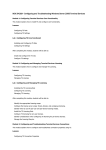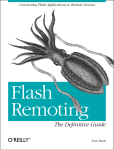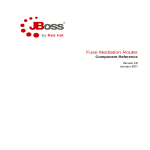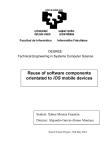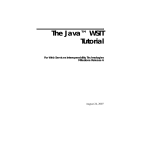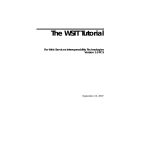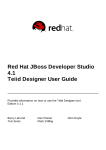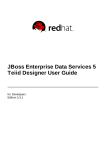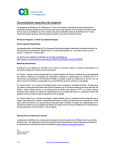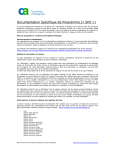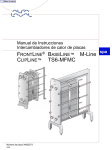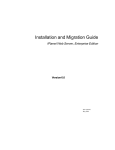Download JBoss WS CXF User Guide - for use with JBoss
Transcript
JBoss Enterprise Application Platform 5 JBoss WS CXF User Guide for use with JBoss Enterprise Application Platform 5 Alessio Soldano JBoss WS CXF User Guide JBoss Enterprise Application Platform 5 JBoss WS CXF User Guide for use with JBoss Enterprise Application Platform 5 Edition 5.1.1 Author Editor Editor Alessio Soldano Rebecca Newton Elspeth Thorne [email protected] [email protected] [email protected] Copyright © 2011 Red Hat, Inc. The text of and illustrations in this document are licensed by Red Hat under a Creative Commons Attribution–Share Alike 3.0 Unported license ("CC-BY-SA"). An explanation of CC-BY-SA is available at http://creativecommons.org/licenses/by-sa/3.0/. In accordance with CC-BY-SA, if you distribute this document or an adaptation of it, you must provide the URL for the original version. Red Hat, as the licensor of this document, waives the right to enforce, and agrees not to assert, Section 4d of CC-BY-SA to the fullest extent permitted by applicable law. Red Hat, Red Hat Enterprise Linux, the Shadowman logo, JBoss, MetaMatrix, Fedora, the Infinity Logo, and RHCE are trademarks of Red Hat, Inc., registered in the United States and other countries. Linux® is the registered trademark of Linus Torvalds in the United States and other countries. Java® is a registered trademark of Oracle and/or its affiliates. XFS® is a trademark of Silicon Graphics International Corp. or its subsidiaries in the United States and/or other countries. MySQL® is a registered trademark of MySQL AB in the United States, the European Union and other countries. Apache CXF, CXF, and WSS4J are trademarks of The Apache Software Foundation. All other trademarks are the property of their respective owners. This is a guide for installing and running JBoss WS CXF with JBoss Enterprise Application Platform 5 and its patch releases. It includes installation, configuration and tutorials. Preface v 1. Document Conventions ................................................................................................... v 1.1. Typographic Conventions ...................................................................................... v 1.2. Pull-quote Conventions ........................................................................................ vi 1.3. Notes and Warnings ............................................................................................ vii 2. Getting Help and Giving Feedback ................................................................................. vii 2.1. Do You Need Help? ............................................................................................ vii 2.2. Give us Feedback .............................................................................................. viii 1. Introduction 1 2. Installation 3 3. Server Side Integration Customization 5 4. WS Addressing 7 4.1. Using JAX-WS for enabling WS-Addressing ................................................................... 7 4.1.1. Using CXF proprietary WSAddressingFeature ..................................................... 7 5. Addressing Tutorial 9 5.1. Turning on WS-Addressing 1.0 .................................................................................. 12 6. WS-Reliable Messaging 15 7. Using WS-Reliable Messaging 17 8. WS-Reliable Messaging Tutorial 8.1. Generating WSDL and JAX-WS Endpoint Artifacts ...................................................... 8.2. Generating JAX-WS Client Artifacts ............................................................................. 8.3. Turning on WS-RM 1.0 .............................................................................................. 21 21 23 25 9. WS Policy Framework 31 9.1. Using The Policies Feature ........................................................................................ 31 9.2. Specifying the Location of External Attachments ......................................................... 31 10. WS-Security 33 10.1. Overview of Encryption and Signing ......................................................................... 33 11. WSS4J security on JBoss 11.1. Creating the web service endpoint ............................................................................ 11.2. Turn on WS-Security ............................................................................................... 11.2.1. Package and deploy ..................................................................................... 11.3. WS-Security Policies ................................................................................................ 11.4. Authentication ........................................................................................................... 11.5. Further Information .................................................................................................. 11.5.1. Samples ....................................................................................................... 11.5.2. Username/password configuration .................................................................. 11.5.3. Crypto Algorithms ......................................................................................... 35 35 35 38 39 40 43 43 43 44 12. SOAP Message Logging 45 12.1. Debugging Tools ..................................................................................................... 46 A. Revision History 47 iii iv Preface 1. Document Conventions This manual uses several conventions to highlight certain words and phrases and draw attention to specific pieces of information. 1 In PDF and paper editions, this manual uses typefaces drawn from the Liberation Fonts set. The Liberation Fonts set is also used in HTML editions if the set is installed on your system. If not, alternative but equivalent typefaces are displayed. Note: Red Hat Enterprise Linux 5 and later includes the Liberation Fonts set by default. 1.1. Typographic Conventions Four typographic conventions are used to call attention to specific words and phrases. These conventions, and the circumstances they apply to, are as follows. Mono-spaced Bold Used to highlight system input, including shell commands, file names and paths. Also used to highlight keycaps and key combinations. For example: To see the contents of the file my_next_bestselling_novel in your current working directory, enter the cat my_next_bestselling_novel command at the shell prompt and press Enter to execute the command. The above includes a file name, a shell command and a keycap, all presented in mono-spaced bold and all distinguishable thanks to context. Key combinations can be distinguished from keycaps by the hyphen connecting each part of a key combination. For example: Press Enter to execute the command. Press Ctrl+Alt+F2 to switch to the first virtual terminal. Press Ctrl+Alt+F1 to return to your X-Windows session. The first paragraph highlights the particular keycap to press. The second highlights two key combinations (each a set of three keycaps with each set pressed simultaneously). If source code is discussed, class names, methods, functions, variable names and returned values mentioned within a paragraph will be presented as above, in mono-spaced bold. For example: File-related classes include filesystem for file systems, file for files, and dir for directories. Each class has its own associated set of permissions. Proportional Bold This denotes words or phrases encountered on a system, including application names; dialog box text; labeled buttons; check-box and radio button labels; menu titles and sub-menu titles. For example: Choose System → Preferences → Mouse from the main menu bar to launch Mouse Preferences. In the Buttons tab, click the Left-handed mouse check box and click 1 https://fedorahosted.org/liberation-fonts/ v Preface Close to switch the primary mouse button from the left to the right (making the mouse suitable for use in the left hand). To insert a special character into a gedit file, choose Applications → Accessories → Character Map from the main menu bar. Next, choose Search → Find… from the Character Map menu bar, type the name of the character in the Search field and click Next. The character you sought will be highlighted in the Character Table. Doubleclick this highlighted character to place it in the Text to copy field and then click the Copy button. Now switch back to your document and choose Edit → Paste from the gedit menu bar. The above text includes application names; system-wide menu names and items; application-specific menu names; and buttons and text found within a GUI interface, all presented in proportional bold and all distinguishable by context. Mono-spaced Bold Italic or Proportional Bold Italic Whether mono-spaced bold or proportional bold, the addition of italics indicates replaceable or variable text. Italics denotes text you do not input literally or displayed text that changes depending on circumstance. For example: To connect to a remote machine using ssh, type ssh [email protected] at a shell prompt. If the remote machine is example.com and your username on that machine is john, type ssh [email protected]. The mount -o remount file-system command remounts the named file system. For example, to remount the /home file system, the command is mount -o remount /home. To see the version of a currently installed package, use the rpm -q package command. It will return a result as follows: package-version-release. Note the words in bold italics above — username, domain.name, file-system, package, version and release. Each word is a placeholder, either for text you enter when issuing a command or for text displayed by the system. Aside from standard usage for presenting the title of a work, italics denotes the first use of a new and important term. For example: Publican is a DocBook publishing system. 1.2. Pull-quote Conventions Terminal output and source code listings are set off visually from the surrounding text. Output sent to a terminal is set in mono-spaced roman and presented thus: books books_tests Desktop Desktop1 documentation downloads drafts images mss notes photos scripts stuff svgs svn Source-code listings are also set in mono-spaced roman but add syntax highlighting as follows: package org.jboss.book.jca.ex1; import javax.naming.InitialContext; vi Notes and Warnings public class ExClient { public static void main(String args[]) throws Exception { InitialContext iniCtx = new InitialContext(); Object ref = iniCtx.lookup("EchoBean"); EchoHome home = (EchoHome) ref; Echo echo = home.create(); System.out.println("Created Echo"); System.out.println("Echo.echo('Hello') = " + echo.echo("Hello")); } } 1.3. Notes and Warnings Finally, we use three visual styles to draw attention to information that might otherwise be overlooked. Note Notes are tips, shortcuts or alternative approaches to the task at hand. Ignoring a note should have no negative consequences, but you might miss out on a trick that makes your life easier. Important Important boxes detail things that are easily missed: configuration changes that only apply to the current session, or services that need restarting before an update will apply. Ignoring a box labeled 'Important' will not cause data loss but may cause irritation and frustration. Warning Warnings should not be ignored. Ignoring warnings will most likely cause data loss. 2. Getting Help and Giving Feedback 2.1. Do You Need Help? If you experience difficulty with a procedure described in this documentation, visit the Red Hat Customer Portal at http://access.redhat.com. Through the customer portal, you can: • search or browse through a knowledgebase of technical support articles about Red Hat products. • submit a support case to Red Hat Global Support Services (GSS). • access other product documentation. Red Hat also hosts a large number of electronic mailing lists for discussion of Red Hat software and technology. You can find a list of publicly available mailing lists at https://www.redhat.com/mailman/ listinfo. Click on the name of any mailing list to subscribe to that list or to access the list archives. vii Preface 2.2. Give us Feedback If you find a typographical error, or know how this guide can be improved, we would love to hear from you. Submit a report in Bugzilla against the product JBoss Enterprise Application Platform 5 and the component doc-JBossWS_CXF_User_Guide. The following link will take you to a pre-filled 2 bug report for this product: http://bugzilla.redhat.com/ . Fill out the following template in Bugzilla's Description field. Be as specific as possible when describing the issue; this will help ensure that we can fix it quickly. Document URL: Section Number and Name: Describe the issue: Suggestions for improvement: Additional information: Be sure to give us your name so that you can receive full credit for reporting the issue. 2 https://bugzilla.redhat.com/enter_bug.cgi?product=JBoss%20Enterprise%20Application%20Platform%205&component=docJBossWS_CXF_User_Guide&version=5.1.1&short_desc=Bug%20in%20CXF%20User%20Guide viii Chapter 1. Introduction JBoss Web Services CXF (JBossWS-CXF) is the JBoss Web Services stack implementation internally based on Apache CXF. Apache CXF is an open source services framework. CXF helps you build and develop services using frontend programming Application Programming Interfaces (APIs), like JAXWS. CXF includes a broad feature set, but it is primarily focused on the following areas: Web Services Standard Support CXF supports a variety of web service standards including: • SOAP • WSI Basic Profile. • WSDL • WS-Addressing • WS-Policy • WS-ReliableMessaging • WS-Security • WS-SecurityPolicy • WS-SecureConversation Frontends CXF supports a variety of frontend programming models. CXF implements the JAX-WS APIs (TCK compliant). It also includes a simple frontend which allows creation of clients and endpoints without annotations. CXF supports both contract first development with WSDL and code first development starting from Java. Ease of use CXF is designed to be intuitive and easy to use. • There are simple APIs to quickly build code-first services. • Maven plug-ins to make tooling integration easy. • JAX-WS API support. • Spring 2.x XML support to make configuration easier. 1 2 Chapter 2. Installation Warning Installing JBoss Web Services CXF is irreversible. You should make a complete backup of your JBoss Enterprise Application Platform installation before installing JBoss Web Services CXF. Follow these steps to install JBoss Web Services CXF: Procedure 2.1. Installing CXF 1. Download the Installer Download and unzip the jboss-ep-ws-cxf-5.1.0-installer.zip in the home jboss-as directory directly under the Platform installation root. 2. Replace WS Native with WS CXF Run ant in the created directory, jbossws-cxf-installer. Note This step will replace JBoss Web Services Native with JBoss Web Services CXF in every configuration that contains JBoss Web Services Native. After completing the process, you should be able to access JBossWS under http:// localhost:8080/jbossws 3 4 Chapter 3. Server Side Integration Customization JBossWS-CXF allows users to deploy their webservice endpoints by simply providing their archives the same way they used to do with JBossWS-Native. However, it is possible to customize the JBossWS and CXF integration by incorporating a CXF configuration file to the endpoint deployment archive. The convention is the following: • The file name must be jbossws-cxf.xml • For POJO deployments it is located in WEB-INF directory • For EJB3 deployments it is located in META-INF directory If the user does not provide their own CXF configuration file, the default one will be automatically generated during the runtime. For POJO deployments the generated jbossws-cxf.xml has the following content: <beans xmlns='http://www.springframework.org/schema/beans' xmlns:xsi='http://www.w3.org/2001/XMLSchema-instance' xmlns:beans='http://www.springframework.org/schema/beans' xmlns:jaxws='http://cxf.apache.org/jaxws' xsi:schemaLocation='http://www.springframework.org/schema/beans http://www.springframework.org/schema/beans/spring-beans.xsd http://cxf.apache.org/jaxws http://cxf.apache.org/schemas/jaxws.xsd'> <!-- one or more jaxws:endpoint POJO declarations --> <jaxws:endpoint id='POJOEndpoint' address='http://localhost:8080/pojo_endpoint_archive_name' implementor='my.package.POJOEndpointImpl'> <jaxws:invoker> <bean class='org.jboss.wsf.stack.cxf.InvokerJSE'/> </jaxws:invoker> </jaxws:endpoint> </beans> For EJB3 deployments the generated jbossws-cxf.xml has the following content: <beans xmlns='http://www.springframework.org/schema/beans' xmlns:xsi='http://www.w3.org/2001/XMLSchema-instance' xmlns:beans='http://www.springframework.org/schema/beans' xmlns:jaxws='http://cxf.apache.org/jaxws' xsi:schemaLocation='http://www.springframework.org/schema/beans http://www.springframework.org/schema/beans/spring-beans.xsd http://cxf.apache.org/jaxws http://cxf.apache.org/schemas/jaxws.xsd'> <!-- one or more jaxws:endpoint EJB3 declarations --> <jaxws:endpoint id='EJB3Endpoint' address='http://localhost:8080/ejb3_endpoint_archive_name' implementor='my.package.EJB3EndpointImpl'> <jaxws:invoker> <bean class='org.jboss.wsf.stack.cxf.InvokerEJB3'/> </jaxws:invoker> </jaxws:endpoint> </beans> 5 Chapter 3. Server Side Integration Customization Providing custom CXF configuration to the endpoint deployment is useful in cases when users want to use features that are not part of standard JAX-WS specification but CXF still implements them. See Chapter 8, WS-Reliable Messaging Tutorial for more information. We provide custom CXF endpoint configuration there to turn on WS-RM feature for the endpoint. Note When the user incorporates their own CXF configuration to the endpoint archive they must reference either org.jboss.wsf.stack.cxf.InvokerJSE or the org.jboss.wsf.stack.cxf.InvokerEJB3 JAX-WS invoker bean there for each JAX-WS endpoint. 6 Chapter 4. WS Addressing CXF provides support for the 2004-08 and 1.0 versions of WS-Addressing. Users can enable WSAddressing either using the standard JAX-WS approach or using the Apache CXF WS Addressing Feature on their service. 4.1. Using JAX-WS for enabling WS-Addressing As per JAX-WS 2.1 specification, users can enable WS-Addressing on a web service endpoint by simply adding the @javax.xml.soap.Addressing annotation. package org.jboss.test.ws.jaxws.samples.wsa; import javax.jws.WebService; import javax.xml.ws.soap.Addressing; @WebService @Addressing(enabled=true, required=true) public class ServiceImpl implements ServiceIface { public String sayHello() { return "Hello World!"; } } On the client side, WS-Addressing can be explicitly enabled by providing org.apache.cxf.ws.addressing.WSAddressingFeature when getting the proxy instance from the service: ServiceIface proxy = (ServiceIface)service.getPort(ServiceIface.class, new AddressingFeature()); proxy.sayHello()); 4.1.1. Using CXF proprietary WSAddressingFeature To enable WS-Addressing, enable the WSAddressingFeature on your service. If you wish to use XML to configure this, use the following syntax: <jaxws:endpoint id="{your.service.namespace}YourPortName"> <jaxws:features> <wsa:addressing xmlns:wsa="http://cxf.apache.org/ws/addressing"/> </jaxws:features> </jaxws:endpoint> You can also use the same exact syntax with a <jaxws:client>: <jaxws:client id="{your.service.namespace}YourPortName"> <jaxws:features> <wsa:addressing xmlns:wsa="http://cxf.apache.org/ws/addressing"/> </jaxws:features> </jaxws:client> 7 8 Chapter 5. Addressing Tutorial This tutorial will show you how to create client and endpoint communication with WS-Addressing enabled. Creating a WS-Addressing based service and client is very simple. The first step is to create regular JAX-WS service and client configuration; the last step is to configure the addressing on both sides. The Service We will start with the following endpoint implementation. package org.jboss.test.ws.jaxws.samples.wsa; import javax.jws.WebService; @WebService ( portName = "AddressingServicePort", serviceName = "AddressingService", targetNamespace = "http://www.jboss.org/jbossws/ws-extensions/wsaddressing", endpointInterface = "org.jboss.test.ws.jaxws.samples.wsa.ServiceIface" ) public class ServiceImpl implements ServiceIface { public String sayHello() { return "Hello World!"; } } The above endpoint implements the following endpoint interface: package org.jboss.test.ws.jaxws.samples.wsa; import javax.jws.WebMethod; import javax.jws.WebService; @WebService ( targetNamespace = "http://www.jboss.org/jbossws/ws-extensions/wsaddressing" ) public interface ServiceIface { @WebMethod String sayHello(); } Let's say that compiled endpoint and interface classes are located in directory /home/username/ wsa/cxf/classes. The next step is to generate the JAX-WS artifacts and WSDL that will be part of the endpoint archive. Generating WSDL and JAX-WS Endpoint Artifacts We will use the wsprovide commandline tool to generate WSDL and JAX-WS artifacts. Here's the command: cd JBOSS_HOME/bin ./wsprovide.sh --keep --wsdl \ 9 Chapter 5. Addressing Tutorial --classpath=/home/username/wsa/cxf/classes \ --output=/home/username/wsa/cxf/wsprovide/generated/classes \ --resource=/home/username/wsa/cxf/wsprovide/generated/wsdl \ --source=/home/username/wsa/cxf/wsprovide/generated/src \ org.jboss.test.ws.jaxws.samples.wsa.ServiceImpl The above command generates the following artifacts: Compiled classes SayHello.class SayHelloResponse.class Java Sources SayHello.java SayHelloResponse.java Contract Artifacts AddressingService.wsdl All previously mentioned generated artifacts will be part of the endpoint archive, but before we create the endpoint archive, we need to reference generated WSDL from the endpoint. We will use the wsdlLocation annotation attribute. This is the updated endpoint implementation before it is packaged to the war file: package org.jboss.test.ws.jaxws.samples.wsa; import javax.jws.WebService; @WebService ( portName = "AddressingServicePort", serviceName = "AddressingService", wsdlLocation = "WEB-INF/wsdl/AddressingService.wsdl", targetNamespace = "http://www.jboss.org/jbossws/ws-extensions/wsaddressing", endpointInterface = "org.jboss.test.ws.jaxws.samples.wsa.ServiceIface" ) public class ServiceImpl implements ServiceIface { public String sayHello() { return "Hello World!"; } } The created endpoint war archive consists of the following entries: jar -tvf jaxws-samples-wsa.war 0 Mon Apr 21 20:39:30 CEST 2008 106 Mon Apr 21 20:39:28 CEST 2008 0 Mon Apr 21 20:39:30 CEST 2008 593 Mon Apr 21 20:39:28 CEST 2008 0 Mon Apr 21 20:39:30 CEST 2008 0 Mon Apr 21 20:39:26 CEST 2008 0 Mon Apr 21 20:39:26 CEST 2008 0 Mon Apr 21 20:39:26 CEST 2008 0 Mon Apr 21 20:39:26 CEST 2008 0 Mon Apr 21 20:39:26 CEST 2008 0 Mon Apr 21 20:39:26 CEST 2008 10 META-INF/ META-INF/MANIFEST.MF WEB-INF/ WEB-INF/web.xml WEB-INF/classes/ WEB-INF/classes/org/ WEB-INF/classes/org/jboss/ WEB-INF/classes/org/jboss/test/ WEB-INF/classes/org/jboss/test/ws/ WEB-INF/classes/org/jboss/test/ws/jaxws/ WEB-INF/classes/org/jboss/test/ws/jaxws/samples/ 0 Mon Apr 21 20:39:26 CEST 374 Mon Apr 21 20:39:26 CEST ServiceIface.class 954 Mon Apr 21 20:39:26 CEST ServiceImpl.class 0 Mon Apr 21 20:39:26 CEST jaxws/ 703 Mon Apr 21 20:39:26 CEST jaxws/SayHello.class 1074 Mon Apr 21 20:39:26 CEST jaxws/SayHelloResponse.class 0 Mon Apr 21 20:39:30 CEST 2378 Mon Apr 21 20:39:28 CEST 2008 WEB-INF/classes/org/jboss/test/ws/jaxws/samples/wsa/ 2008 WEB-INF/classes/org/jboss/test/ws/jaxws/samples/wsa/ 2008 WEB-INF/classes/org/jboss/test/ws/jaxws/samples/wsa/ 2008 WEB-INF/classes/org/jboss/test/ws/jaxws/samples/wsa/ 2008 WEB-INF/classes/org/jboss/test/ws/jaxws/samples/wsa/ 2008 WEB-INF/classes/org/jboss/test/ws/jaxws/samples/wsa/ 2008 WEB-INF/wsdl/ 2008 WEB-INF/wsdl/AddressingService.wsdl The content of the web.xml file is: <?xml version="1.0" encoding="UTF-8"?> <web-app version="2.5" xmlns="http://java.sun.com/xml/ns/javaee" xmlns:xsi="http://www.w3.org/2001/XMLSchema-instance" xsi:schemaLocation="http://java.sun.com/xml/ns/javaee http://java.sun.com/xml/ns/javaee/ web-app_2_5.xsd"> <servlet> <servlet-name>AddressingService</servlet-name> <servlet-class>org.jboss.test.ws.jaxws.samples.wsa.ServiceImpl</servlet-class> </servlet> <servlet-mapping> <servlet-name>AddressingService</servlet-name> <url-pattern>/*</url-pattern> </servlet-mapping> </web-app> Writing Regular JAX-WS Client The following is the regular JAX-WS client using endpoint interface to lookup the webservice: package.org.jboss.test.ws.jaxws.samples.wsa: package.org.jboss.test.ws.jaxws.samples.wsa: import java.net.URL; import javax.xml.namespace.QName; import javax.xml.ws.Service; public final class SimpleServiceTestCase { private final String serviceURL = "http://localhost:8080/jaxws-samples-wsa/ AddressingService"; public static void main(String[] args) throws Exception { // create service QName serviceName = new QName("http://www.jboss.org/jbossws/ws-extensions/ wsaddressing", "AddressingService"); URL wsdlURL = new URL(serviceURL + "?wsdl"); Service service = Service.create(wsdlURL, serviceName); ServiceIface proxy = (ServiceIface)service.getPort(ServiceIface.class); // invoke method proxy.sayHello(); } 11 Chapter 5. Addressing Tutorial } We have both endpoint and client implementations but without WS-Addressing in place. Our next goal is to turn on the WS-Addressing feature. 5.1. Turning on WS-Addressing 1.0 There are two steps remaining in order to turn on WS-Addressing in JbossWS-CXF. • Annotate service endpoint with @Addressing annotation. • Modify client to configure WS-Addressing using the JAX-WS webservice feature. Updating Endpoint Code to Configure WS-Addressing Now we need to update endpoint implementation to configure WS-Addressing. Here's the updated endpoint code: package org.jboss.test.ws.jaxws.samples.wsa; import javax.jws.WebService; import javax.xml.ws.soap.Addressing; @WebService ( portName = "AddressingServicePort", serviceName = "AddressingService", wsdlLocation = "WEB-INF/wsdl/AddressingService.wsdl", targetNamespace = "http://www.jboss.org/jbossws/ws-extensions/wsaddressing", endpointInterface = "org.jboss.test.ws.jaxws.samples.wsa.ServiceIface" ) @Addressing(enabled=true, required=true) public class ServiceImpl implements ServiceIface { public String sayHello() { return "Hello World!"; } } We have added the JAX-WS 2.1 Addressing annotation to configure WS-Addressing. The next step is to repackage the endpoint archive to apply this change. Updating Client Code to Configure WS-Addressing We need to update client implementation to configure WS-Addressing. Here's the updated client code: package org.jboss.test.ws.jaxws.samples.wsa; import import import import java.net.URL; javax.xml.namespace.QName; javax.xml.ws.Service; javax.xml.ws.soap.AddressingFeature; public final class AddressingTestCase { private final String serviceURL = "http://localhost:8080/jaxws-samples-wsa/ AddressingService"; 12 Turning on WS-Addressing 1.0 public static void main(String[] args) throws Exception { // construct proxy QName serviceName = new QName("http://www.jboss.org/jbossws/ws-extensions/ wsaddressing", "AddressingService"); URL wsdlURL = new URL(serviceURL + "?wsdl"); Service service = Service.create(wsdlURL, serviceName); ServiceIface proxy = (ServiceIface)service.getPort(ServiceIface.class, new AddressingFeature()); // invoke method proxy.sayHello(); } } We now have both JAX-WS client and endpoint communicating with each other using WS-Addressing. 13 14 Chapter 6. WS-Reliable Messaging CXF supports the February 2005 version of the Web Service Reliable Messaging Protocol specification. Like most other features in CXF, it is interceptor based. The WS-Reliable Messaging implementation consists of four interceptors in total. These are listed below. org.apache.cxf.ws.rm.RMOutInterceptor Responsible for: • Sending CreateSequence requests. • Waiting for their CreateSequenceResponse responses. • Collecting the sequence properties (id and message number) for an application message. org.apache.cxf.ws.rm.RMInInterceptor Intercepting and processing RM protocol messages, as well as SequenceAcknowledgments piggybacked on application messages. org.apache.cxf.ws.rm.soap.RMSoapInterceptor Encoding and decoding the RM headers org.apache.cxf.ws.rm.soap.RetransmissionInterceptor Responsible for creating copies of application messages for future resends. Interceptor Based QoS The presence of the RM interceptors on the respective interceptor chains alone will ensure that RM protocol messages are exchanged when necessary. For example, upon intercepting the first application message on the outbound interceptor chain, the RMOutInterceptor will send a CreateSequence request and only proceed with processing the original application message after it has the CreateSequenceResponse response. The RM interceptors are also responsible for adding the sequence headers to the application messages and, on the destination side, extracting them from the message. This means that no changes to the application code are required to make the message exchange reliable. You can still control sequence demarcation and other aspects of the reliable exchange through configuration. By default, CXF attempts to maximize the lifetime of a sequence. This reduces the overhead incurred by the RM protocol messages, however you can choose to enforce the use of a separate sequence per application message by configuring the source of the RM sequence termination policy (setting the maximum sequence length to one). See the Chapter 7, Using WSReliable Messaging for more details on configuring this and other aspects of the reliable exchange. 15 16 Chapter 7. Using WS-Reliable Messaging In order for JBoss WS-CXF/CXF to establish reliable messaging between two points, the CXF RM and addressing interceptors need to be added to the interceptor chains. This can be achieved in one of the ways outlined below. Using the RMAssertion and the CXF WS-Policy Framework The RM interceptors will be automatically added to their respective interceptor chains by the policy framework if the following occurs: 1. A Policy with an RMAssertion element is attached to the wsdl:service element (or any other WSDL element that is an attachment point for Policy or PolicyReference elements according to the rules for WS-Policy Attachments). 2. The CXF WS-Policy Framework is enabled The assertion attributes control the behavior of the source or destination. For example, to enable the WS-Policy Framework on the server side, your configuration file will look like this: <jaxws:endpoint ...> <jaxws:features> <p:policies/> </jaxws:features> </jaxws:endpoint> Your WSDL will look like this: <wsp:Policy wsu:Id="RM" xmlns:wsp="http://www.w3.org/2006/07/ws-policy" xmlns:wsu="http://docs.oasis-open.org/wss/2004/01/oasis-200401-wss-wssecurityutility-1.0.xsd"> <wsam:Addressing xmlns:wsam="http://www.w3.org/2007/02/addressing/metadata"> <wsp:Policy/> </wsam:Addressing> <wsrmp:RMAssertion xmlns:wsrmp="http://schemas.xmlsoap.org/ws/2005/02/rm/policy"> <wsrmp:BaseRetransmissionInterval Milliseconds="10000"/> </wsrmp:RMAssertion> </wsp:Policy> ... <wsdl:service name="ReliableGreeterService"> <wsdl:port binding="tns:GreeterSOAPBinding" name="GreeterPort"> <soap:address location="http://localhost:9020/SoapContext/GreeterPort"/> <wsp:PolicyReference URI="#RM" xmlns:wsp="http://www.w3.org/2006/07/ws-policy"/> </wsdl:port> </wsdl:service> Instead of attaching the PolicyReference to the wsdl:port element, you can also specify it as a child element of the policies featured, such as the server endpoint. <wsp:Policy wsu:Id="="RM" xmlns:wsp="http://www.w3.org/2006/07/ws-policy" ...> </wsp:Policy> <jaxws:endpoint ...> <jaxws:features> <p:policies> 17 Chapter 7. Using WS-Reliable Messaging <wsp:PolicyReference URI="#RM" xmlns:wsp="http://www.w3.org/2006/07/ws-policy"/> </p:policies> </jaxws:features> </jaxws:endpoint> Using the Reliable Messaging Feature You can use the ReliableMessaging feature if you do not want to involve the WS-Policy Framework, or want to configure additional parameters such as the sequence termination policy or the persistent store. The supported child elements are listed below. RMAssertion An element of type RMAssertion. deliveryAssurance An element of type DeliveryAssuranceType that describes the delivery assurance that should apply (AtMostOnce, AtLeastOnce, InOrder). sourcePolicy An element of type SourcePolicyType that allows you to configure details of the RM source, such as whether an offer should always be included in a CreateSequence request, or the sequence termination policy. destinationPolicy An element of type DestinationPolicyType that allows you to configure details of the RM destination, such as whether inbound offers should be accepted. store The store to use (default: null). This must be an element of type jdbcStore (in the same namespace), or a bean or a reference to a bean that implements the RMStore interface. The jbdcStore element type is described below. The following example is applied at bus level. <cxf:bus> <cxf:features> <wsa:addressing/> <wsrm-mgr:reliableMessaging> <wsrm-policy:RMAssertion> <wsrm-policy:BaseRetransmissionInterval Milliseconds="4000"/> <wsrm-policy:AcknowledgementInterval Milliseconds="2000"/> </wsrm-policy:RMAssertion> <wsrm-mgr:sourcePolicy> <wsrm-mgr:sequenceTerminationPolicy maxLength="5"/> </wsrm-mgr:sourcePolicy> <wsrm-mgr:destinationPolicy acceptOffers="false"> <wsrm:store> <ref bean="myStore"/> </wsrm:store> </wsrm-mgr:reliableMessaging> </cxf:features> </cxf:bus> Configuring the Reliable Messaging Store To enable persistence, you must specify the object implementing the persistent store for RM. You can develop your own, or use the JDBC based store that comes with CXF (class 18 org.apache.cxf.ws.rm.persistence.jdbc.RMTxStore). You can configure the latter using a custom jdbcStore bean. The supported attributes are in the table below. Table 7.1. Attributes Attribute name String Default driverClassName String org.apache.derby.jdbc.EmbeddedDriver userName String null passWord String null url String jdbc:derby:rmdb;create=true Here is an example: <wsrm-mgr:jdbcStore id="myStore" driverClassName="org.apache.derby.jdbc.ClientDriver" url="jdbc:derby://localhost:1527/rmdb;create=true" password="password"/> Configuring the Reliable Messaging Manager Manually To configure properties of the RM Manager, you can use the RMManager element. It supports the same child elements as the ReliableMessaging feature element above. For example, without using features, you can determine that sequences should have a maximum length of five as follows: <wsrm-mgr:rmManager xmlns:wsrm-mgr="http://cxf.apache.org/ws/rm/manager"> <wsrm-mgr:sourcePolicy> <wsrm-mgr:sequenceTerminationPolicy maxLength="5"/> </wsrm-mgr:sourcePolicy> </wsrm-mgr:rmManager> 19 20 Chapter 8. WS-Reliable Messaging Tutorial In this sample we show you how to create client and endpoint communication using WS-Reliable Messaging 1.0. Creating the WS-RM based service and client is very simple. The user needs to create regular JAX-WS service and client first. The last step is to configure WS-RM. We will start with the following endpoint implementation: package org.jboss.test.ws.jaxws.samples.wsrm.service; import javax.jws.Oneway; import javax.jws.WebMethod; import javax.jws.WebService; @WebService ( name = "SimpleService", serviceName = "SimpleService", targetNamespace = "http://www.jboss.org/jbossws/ws-extensions/wsrm" ) public class SimpleServiceImpl { @Oneway @WebMethod public void ping() { System.out.println("ping()"); } @WebMethod public String echo(String s) { System.out.println("echo(" + s + ")"); return s; } } Let's say that compiled endpoint class is in directory /home/username/wsrm/cxf/classes. Our next step is to generate JAX-WS artifacts and WSSDL. 8.1. Generating WSDL and JAX-WS Endpoint Artifacts We will use the wsprovide commandline tool to generate WSDL and JAX-WS artifacts. Here's the command: cd $JBOSS_HOME/bin ./wsprovide.sh --keep --wsdl \ --classpath=/home/username/wsrm/cxf/classes \ --output=/home/username/wsrm/cxf/wsprovide/generated/classes \ --resource=/home/username/wsrm/cxf/wsprovide/generated/wsdl \ --source=/home/username/wsrm/cxf/wsprovide/generated/src \ org.jboss.test.ws.jaxws.samples.wsrm.service.SimpleServiceImpl The above command generates the following artifacts: Compiled classes Echo.class Echo response.class 21 Chapter 8. WS-Reliable Messaging Tutorial Ping.class Java sources Echo.java EchoResponse.java Ping.java Contract artifacts SimpleService.wsdl The artifacts generated above will be part of the endpoint archive, but before we create the endpoint archive we need to reference generated WSDL from the endpoint. To achieve that we will use the wsdlLocation annotation attribute. Here's the updated endpoint implementation before it is packaged to the war file: package org.jboss.test.ws.jaxws.samples.wsrm.service; import javax.jws.Oneway; import javax.jws.WebMethod; import javax.jws.WebService; @WebService ( name = "SimpleService", serviceName = "SimpleService", wsdlLocation = "WEB-INF/wsdl/SimpleService.wsdl", targetNamespace = "http://www.jboss.org/jbossws/ws-extensions/wsrm" ) public class SimpleServiceImpl { @Oneway @WebMethod public void ping() { System.out.println("ping()"); } @WebMethod public String echo(String s) { System.out.println("echo(" + s + ")"); return s; } } The created endpoint war archive consists of the following entries: jar -tvf jaxws-samples-wsrm.war 0 Wed Apr 16 14:39:22 CEST 106 Wed Apr 16 14:39:20 CEST 0 Wed Apr 16 14:39:22 CEST 591 Wed Apr 16 14:39:20 CEST 0 Wed Apr 16 14:39:22 CEST 0 Wed Apr 16 14:39:18 CEST 0 Wed Apr 16 14:39:18 CEST 0 Wed Apr 16 14:39:18 CEST 0 Wed Apr 16 14:39:18 CEST 0 Wed Apr 16 14:39:20 CEST 0 Wed Apr 16 14:39:20 CEST 22 2008 2008 2008 2008 2008 2008 2008 2008 2008 2008 2008 META-INF/ META-INF/MANIFEST.MF WEB-INF/ WEB-INF/web.xml WEB-INF/classes/ WEB-INF/classes/org/ WEB-INF/classes/org/jboss/ WEB-INF/classes/org/jboss/test/ WEB-INF/classes/org/jboss/test/ws/ WEB-INF/classes/org/jboss/test/ws/jaxws/ WEB-INF/classes/org/jboss/test/ws/jaxws/samples/ Generating JAX-WS Client Artifacts 0 Wed Apr 16 14:39:18 CEST 2008 0 Wed Apr 16 14:39:18 CEST 2008 service/ 0 Wed Apr 16 14:39:18 CEST 2008 service/jaxws/ 1235 Wed Apr 16 14:39:18 CEST 2008 service/SimpleServiceImpl.class 997 Wed Apr 16 14:39:18 CEST 2008 service/jaxws/Echo.class 1050 Wed Apr 16 14:39:18 CEST 2008 service/jaxws/EchoResponse.class 679 Wed Apr 16 14:39:18 CEST 2008 service/jaxws/Ping.class 0 Wed Apr 16 14:39:22 CEST 2008 2799 Wed Apr 16 14:39:20 CEST 2008 WEB-INF/classes/org/jboss/test/ws/jaxws/samples/wsrm/ WEB-INF/classes/org/jboss/test/ws/jaxws/samples/wsrm/ WEB-INF/classes/org/jboss/test/ws/jaxws/samples/wsrm/ WEB-INF/classes/org/jboss/test/ws/jaxws/samples/wsrm/ WEB-INF/classes/org/jboss/test/ws/jaxws/samples/wsrm/ WEB-INF/classes/org/jboss/test/ws/jaxws/samples/wsrm/ WEB-INF/classes/org/jboss/test/ws/jaxws/samples/wsrm/ WEB-INF/wsdl/ WEB-INF/wsdl/SimpleService.wsdl The content of web.xml file is: <?xml version="1.0" encoding="UTF-8"?> <web-app version="2.5" xmlns="http://java.sun.com/xml/ns/javaee" xmlns:xsi="http://www.w3.org/2001/XMLSchema-instance" xsi:schemaLocation="http://java.sun.com/xml/ns/javaee http://java.sun.com/xml/ns/javaee/ web-app_2_5.xsd"> <servlet> <servlet-name>SimpleService</servlet-name> <servlet-class>org.jboss.test.ws.jaxws.samples.wsrm.service.SimpleServiceImpl</servletclass> </servlet> <servlet-mapping> <servlet-name>SimpleService</servlet-name> <url-pattern>/*</url-pattern> </servlet-mapping> </web-app> 8.2. Generating JAX-WS Client Artifacts Before we write the regular JAX-WS client we need to generate client artifacts from WSDL. Here's the command to achieve that: cd $JBOSS_HOME/bin ./wsconsume.sh --keep \ --package=org.jboss.test.ws.jaxws.samples.wsrm.generated \ --output=/home/username/wsrm/cxf/wsconsume/generated/classes \ --source=/home/username/wsrm/cxf/wsconsume/generated/src \ /home/username/wsrm/cxf/wsprovide/generated/wsdl/SimpleService.wsdl The artifacts that have been generated are below. Compiled classes Echo.class ObjectFactory.class Ping.class SimpleService_Service.class 23 Chapter 8. WS-Reliable Messaging Tutorial EchoResponse.class package-info.class SimpleService.class SimpleService_SimpleServicePort_Client.class Java sources Echo.java ObjectFactory.java Ping.java SimpleService_Service.java EchoResponse.java package-info.java SimpleService.java SimpleService_SimpleServicePort_Client.java The last step is to write the regular JAX-WS client using generated artifacts. Writing Regular JAX-WS Client The following is the regular JAX-WS client using generated artifacts: package org.jboss.test.ws.jaxws.samples.wsrm.client; import import import import java.net.URL; javax.xml.namespace.QName; javax.xml.ws.Service; org.jboss.test.ws.jaxws.samples.wsrm.generated.SimpleService; public final class SimpleServiceTestCase { private static final String serviceURL = "http://localhost:8080/jaxws-samples-wsrm/ SimpleService"; public static void main(String[] args) throws Exception { // create service QName serviceName = new QName("http://www.jboss.org/jbossws/ws-extensions/ wsrm", "SimpleService"); URL wsdlURL = new URL(serviceURL + "?wsdl"); Service service = Service.create(wsdlURL, serviceName); SimpleService proxy = (SimpleService)service.getPort(SimpleService.class); // invoke methods proxy.ping(); // one way call proxy.echo("Hello World!"); // request responce call } } Now we have both endpoint and clinet implementations but without WS-Reliable Messaging in place. Our next goal is to turn on the WS-RM feature. 24 Turning on WS-RM 1.0 8.3. Turning on WS-RM 1.0 Four steps are necessary to turn on WS-RM in JBossWS-CXF. They are outline below. • Extend WSDL with WS-Policy containing both WSRM and WS-Addressing policy. • Provide jbossws-cxf.xml endpoint configuration file. • Provide client CXF configuration. • Update client code to read CXF configuration file. Extending WSDL Using WS-Policy To activate WSRM we need to extend WSDL with WSRM and addressing policy. Here is how it looks: <?xml version="1.0" encoding="UTF-8"?> <wsdl:definitions name="SimpleService" targetNamespace="http://www.jboss.org/jbossws/ ws-extensions/wsrm" xmlns:tns="http://www.jboss.org/jbossws/ws-extensions/wsrm" xmlns:xsd="http://www.w3.org/2001/XMLSchema" xmlns:soap="http://schemas.xmlsoap.org/wsdl/ soap/" xmlns:wsdl="http://schemas.xmlsoap.org/wsdl/" xmlns:wsp="http://www.w3.org/2006/07/wspolicy"> <!-- - - - - - - - - - - - - - - - - - - - - - - - - - --> <!-- Created WS-Policy with WSRM addressing assertions --> <!-- - - - - - - - - - - - - - - - - - - - - - - - - - --> <wsp:UsingPolicy/> <wsp:Policy wsu:Id="wsrm10policy" xmlns:wsu="http://docs.oasis-open.org/wss/2004/01/ oasis-200401-wss-wssecurity-utility-1.0.xsd"> <wswa:UsingAddressing xmlns:wswa="http://www.w3.org/2006/05/addressing/wsdl"> <wsp:Policy/> <wswa:UsingAddressing> <wsrmp:RMAssertion xmlns:wsrmp="http://schemas.xmlsoap.org/ws/2005/02/rm/policy"/> </wsp:Policy> <wsdl:types> <xsd:schema xmlns:xsd="http://www.w3.org/2001/XMLSchema" xmlns:tns="http:// www.jboss.org/jbossws/ws-extensions/wsrm" attributeFormDefault="unqualified" elementFormDefault="unqualified" targetNamespace="http://www.jboss.org/jbossws/wsextensions/wsrm"> <xsd:element name="ping" type="tns:ping"/> <xsd:complexType name="ping"> <xsd:sequence/> </xsd:complexType> <xsd:element name="echo" type="tns:echo"/> <xsd:complexType name="echo"> <xsd:sequence> <xsd:element minOccurs="0" name="arg0" type="xsd:string"/> </xsd:sequence> </xsd:complexType> <xsd:element name="echoResponse" type="tns:echoResponse"/> <xsd:complexType name="echoResponse"> <xsd:sequence> <xsd:element minOccurs="0" name="return" type="xsd:string"/> </xsd:sequence> </xsd:complexType> </xsd:schema> </wsdl:types> <wsdl:message name="echoResponse"> <wsdl:part name="parameters" element="tns:echoResponse"> </wsdl:part> </wsdl:message> <wsdl:message name="echo"> <wsdl:part name="parameters" element="tns:echo"> 25 Chapter 8. WS-Reliable Messaging Tutorial </wsdl:part> </wsdl:message> <wsdl:message name="ping"> <wsdl:part name="parameters" element="tns:ping"> </wsdl:part> </wsdl:message> <wsdl:portType name="SimpleService"> <wsdl:operation name="ping"> <wsdl:input name="ping" message="tns:ping"> </wsdl:input> </wsdl:operation> <wsdl:operation name="echo"> <wsdl:input name="echo" message="tns:echo"> </wsdl:input> <wsdl:output name="echoResponse" message="tns:echoResponse"> </wsdl:output> </wsdl:operation> </wsdl:portType> <wsdl:binding name="SimpleServiceSoapBinding" type="tns:SimpleService"> <!-- - - - - - - - - - - - - - - - - - - - --> <!-- Associated WS-Policy with the binding --> <!-- - - - - - - - - - - - - - - - - - - - --> <wsp:PolicyReference URI="#wsrm10policy"/> <soap:binding style="document" transport="http://schemas.xmlsoap.org/soap/http"/> <wsdl:operation name="ping"> <soap:operation soapAction="" style="document"/> <wsdl:input name="ping"> <soap:body use="literal"/> </wsdl:input> </wsdl:operation> <wsdl:operation name="echo"> <soap:operation soapAction="" style="document"/> <wsdl:input name="echo"> <soap:body use="literal"/> </wsdl:input> <wsdl:output name="echoResponse"> <soap:body use="literal"/> </wsdl:output> </wsdl:operation> </wsdl:binding> <wsdl:service name="SimpleService"> <wsdl:port name="SimpleServicePort" binding="tns:SimpleServiceSoapBinding"> <soap:address location="http://localhost:9090/hello"/> </wsdl:port> </wsdl:service> </wsdl:definitions> We added wsp:UsingPolicy;wsp:Policy and wsp:PolicyReference elements to WSDL. Providing jbossws-cxf.xml Endpoint Configuration File This is the JBossWS CXF integration extension file: Chapter 3, Server Side Integration Customization . In our case, the relevant content is as follows: <beans xmlns='http://www.springframework.org/schema/beans' xmlns:xsi='http://www.w3.org/2001/XMLSchema-instance' xmlns:beans='http://www.springframework.org/schema/beans' xmlns:jaxws='http://cxf.apache.org/jaxws' xmlns:wsp='http://www.w3.org/2006/07/ws-policy' xmlns:p='http://cxf.apache.org/policy' xsi:schemaLocation='http://www.springframework.org/schema/beans http://www.springframework.org/schema/beans/spring-beans-2.0.xsd 26 Turning on WS-RM 1.0 http://cxf.apache.org/policy http://cxf.apache.org/schemas/policy.xsd http://www.w3.org/2006/07/ws-policy http://www.w3.org/2006/07/ws-policy.xsd http://cxf.apache.org/jaxws http://cxf.apache.org/schemas/jaxws.xsd'> <wsp:Policy wsu:Id="wsrm10policy" xmlns:wsu="http://docs.oasis-open.org/wss/2004/01/ oasis-200401-wss-wssecurity-utility-1.0.xsd"> <wswa:UsingAddressing xmlns:wswa="http://www.w3.org/2006/05/addressing/wsdl"/> <wsrmp:RMAssertion xmlns:wsrmp="http://schemas.xmlsoap.org/ws/2005/02/rm/policy"/> </wsp:Policy> <jaxws:endpoint id='SimpleServiceImpl' address='http://localhost:8080/jaxws-samples-wsrm' implementor='org.jboss.test.ws.jaxws.samples.wsrm.service.SimpleServiceImpl'> <jaxws:invoker> <bean class='org.jboss.wsf.stack.cxf.InvokerJSE'/> </jaxws:invoker> <jaxws:features> <p:policies> <wsp:PolicyReference URI="#wsrm10policy" xmlns:wsp="http://www.w3.org/2006/07/wspolicy"/> </p:policies> </jaxws:features> </jaxws:endpoint> </beans> We need to include this jbossws-cxf.xml CXF configuration file in the WEB-INF directory of the endpoint archive because we are creating a POJO deployment. jar -tvf jaxws-samples-wsrm.war 0 Wed Apr 16 19:05:38 CEST 2008 106 Wed Apr 16 19:05:36 CEST 2008 0 Wed Apr 16 19:05:38 CEST 2008 591 Wed Apr 16 19:05:36 CEST 2008 0 Wed Apr 16 19:05:38 CEST 2008 0 Wed Apr 16 19:05:32 CEST 2008 0 Wed Apr 16 19:05:32 CEST 2008 0 Wed Apr 16 19:05:32 CEST 2008 0 Wed Apr 16 19:05:32 CEST 2008 0 Wed Apr 16 19:05:34 CEST 2008 0 Wed Apr 16 19:05:34 CEST 2008 0 Wed Apr 16 19:05:34 CEST 2008 0 Wed Apr 16 19:05:34 CEST 2008 service/ 0 Wed Apr 16 19:05:34 CEST 2008 service/jaxws/ 1235 Wed Apr 16 19:05:34 CEST 2008 service/SimpleServiceImpl.class 997 Wed Apr 16 19:05:34 CEST 2008 service/jaxws/Echo.class 1050 Wed Apr 16 19:05:34 CEST 2008 service/jaxws/EchoResponse.class 679 Wed Apr 16 19:05:34 CEST 2008 service/jaxws/Ping.class 1554 Wed Apr 16 19:05:36 CEST 2008 0 Wed Apr 16 19:05:38 CEST 2008 3237 Wed Apr 16 19:05:36 CEST 2008 META-INF/ META-INF/MANIFEST.MF WEB-INF/ WEB-INF/web.xml WEB-INF/classes/ WEB-INF/classes/org/ WEB-INF/classes/org/jboss/ WEB-INF/classes/org/jboss/test/ WEB-INF/classes/org/jboss/test/ws/ WEB-INF/classes/org/jboss/test/ws/jaxws/ WEB-INF/classes/org/jboss/test/ws/jaxws/samples/ WEB-INF/classes/org/jboss/test/ws/jaxws/samples/wsrm/ WEB-INF/classes/org/jboss/test/ws/jaxws/samples/wsrm/ WEB-INF/classes/org/jboss/test/ws/jaxws/samples/wsrm/ WEB-INF/classes/org/jboss/test/ws/jaxws/samples/wsrm/ WEB-INF/classes/org/jboss/test/ws/jaxws/samples/wsrm/ WEB-INF/classes/org/jboss/test/ws/jaxws/samples/wsrm/ WEB-INF/classes/org/jboss/test/ws/jaxws/samples/wsrm/ WEB-INF/jbossws-cxf.xml WEB-INF/wsdl/ WEB-INF/wsdl/SimpleService.wsdl 27 Chapter 8. WS-Reliable Messaging Tutorial The next step is to create the client CXF configuration file that will be used by the client. It activates the WS-RM protocol for the CXF client. We will name this file cxf.xml in our sample. The content of this file is as follows: <beans xmlns="http://www.springframework.org/schema/beans" xmlns:xsi="http://www.w3.org/2001/XMLSchema-instance" xmlns:cxf="http://cxf.apache.org/core" xmlns:wsa="http://cxf.apache.org/ws/addressing" xmlns:http="http://cxf.apache.org/transports/http/configuration" xmlns:wsrm-policy="http://schemas.xmlsoap.org/ws/2005/02/rm/policy" xmlns:wsrm-mgr="http://cxf.apache.org/ws/rm/manager" xsi:schemaLocation=" http://cxf.apache.org/core http://cxf.apache.org/schemas/core.xsd http://cxf.apache.org/transports/http/configuration http://cxf.apache.org/schemas/configuration/http-conf.xsd http://schemas.xmlsoap.org/ws/2005/02/rm/policy http://schemas.xmlsoap.org/ws/2005/02/rm/wsrm-policy.xsd http://cxf.apache.org/ws/rm/manager http://cxf.apache.org/schemas/configuration/wsrm-manager.xsd http://www.springframework.org/schema/beans http://www.springframework.org/schema/beans/spring-beans.xsd"> <cxf:bus> <cxf:features> <cxf:logging/> <wsa:addressing/> <wsrm-mgr:reliableMessaging> <wsrm-policy:RMAssertion> <wsrm-policy:BaseRetransmissionInterval Milliseconds="4000"/> <wsrm-policy:AcknowledgementInterval Milliseconds="2000"/> </wsrm-policy:RMAssertion> <wsrm-mgr:destinationPolicy> <wsrm-mgr:acksPolicy intraMessageThreshold="0" /> </wsrm-mgr:destinationPolicy> </wsrm-mgr:reliableMessaging> </cxf:features> </cxf:bus> </beans> We are almost done. The client configuration needs to be picked up by the client classloader. In order to achieve that the cxf.xml has to be put in the META-INF directory of client jar. That jar should then be provided when setting the class loader. Alternatively you can read the bus configuration programmatically. Updating Client Code to Read Bus Configuration File Here's the last piece of the updated CXF client: package org.jboss.test.ws.jaxws.samples.wsrm.client; import import import import import import 28 java.net.URL; java.io.File; javax.xml.namespace.QName; javax.xml.ws.Service; org.apache.cxf.Bus; org.apache.cxf.BusFactory; Turning on WS-RM 1.0 import org.apache.cxf.bus.spring.SpringBusFactory; import org.jboss.test.ws.jaxws.samples.wsrm.generated.SimpleService; public final class SimpleServiceTestCase { private static final String serviceURL = "http://localhost:8080/jaxws-samples-wsrm/ SimpleService"; public static void main(String[] args) throws Exception { // create bus SpringBusFactory busFactory = new SpringBusFactory(); URL cxfConfig = new File("resources/jaxws/samples/wsrm/cxf.xml").toURL(); Bus bus = busFactory.createBus(cxfConfig); busFactory.setDefaultBus(bus); // create service QName serviceName = new QName("http://www.jboss.org/jbossws/ws-extensions/ wsrm", "SimpleService"); URL wsdlURL = new URL(serviceURL + "?wsdl"); Service service = Service.create(wsdlURL, serviceName); SimpleService proxy = (SimpleService)service.getPort(SimpleService.class); // invoke methods proxy.ping(); // one way call proxy.echo("Hello World!"); // request responce call // shutdown bus bus.shutdown(true); } } 29 30 Chapter 9. WS Policy Framework The calculation of the effective policy for each message as well as verification that the alternatives for that policy are supported happens in interceptors. 9.1. Using The Policies Feature The policies feature supports the following attributes: ignoreUnknownAssertions Indicates an exception should be thrown when encountering assertions for which no AssertionBuilders are registered (default:true). When set to false, a warning will be logged instead. namespace The namespace of the WS-Policy Framework specification (default: http://www.w3.org/ns/wspolicy). The element also supports the following child elements: alternativeSelector A bean or reference to a bean that implements the org.apache.cxf.ws.policy.selector.AlternativeSelector interface. The default selector chooses the minimal alternative; that is, the one with the least number of assertions. In addition, the element can have any number of Policy or PolicyReference child elements. This has the same effect as if the Policy or PolicyReference elements were attached to the wsdl:port element of the WSDL contract of the client or server endpoint to which the feature is applied (or to all endpoints if the feature is applied to the bus). For example, to apply this feature to the bus and prevent exceptions being thrown when encountering unknown assertions: <beans xmlns="http://www.springframework.org/schema/beans" xmlns:cxf="http://cxf.apache.org/core" xmlns:p="http://cxf.apache.org/policy" xmlns:xsi="http://www.w3.org/2001/XMLSchema-instance" xsi:schemaLocation=" http://cxf.apache.org/core http://cxf.apache.org/schemas/core.xsd http://cxf.apache.org/policy http://cxf.apache.org/schemas/policy.xsd http://www.springframework.org/schema/beans http://www.springframework.org/schema/beans/ spring-beans.xsd"> <cxf:bus> <cxf:features> <p:policies ignoreUnknownAssertions="true"/> </cxf:features> </cxf:bus> </beans> 9.2. Specifying the Location of External Attachments To specify the location of an external attachment that the policy framework should take into consideration when aggregating the policies applying to a specific message, you can use the <externalAttachment> element in the same namespace. The following attribute is supported. 31 Chapter 9. WS Policy Framework location Location of the external attachment document. This takes the form of http://static.springsource.org/ spring/docs/2.0.x/reference/resources.html type property, for example, classpath:etc/ policies.xml or file:///x1/resources/polcies.xml. Below is an example: <p:externalAttachment location="classpath:org/apache/cxf/systest/ws/policy/addrexternal.xml"/> You can have any number of <externalAttachment> elements in your configuration file. 32 Chapter 10. WS-Security WS-Security provides the means to secure your services beyond transport level protocols such as HTTPS. Through a number of standards such as XML-Encryption, and headers defined in the WSSecurity standard, it allows you to: • Pass authentication tokens between services. • Encrypt messages or parts of messages. • Sign messages. • Timestamp messages. 1 Currently, CXF implements WS-Security by integrating WSS4J . To use the integration, you'll need to configure these interceptors and add them to your service or client respectively. 10.1. Overview of Encryption and Signing WS-Security makes heavy use of public and private key cryptography. It is helpful to understand these basics to really understand how to configure WS-Security. With public key cryptography, a user has a pair of public and private keys. These are generated using a large prime number and a key function. The keys are related mathematically, but cannot be derived from one another. With these keys we can encrypt messages. For example, if Bob wants to send a message to Alice, he can encrypt a message using her public key. Alice can then decrypt this message using her private key. Only Alice can decrypt this message as she is the only one with the private key. Messages can also be signed. This allows you to ensure the authenticity of the message. If Alice wants to send a message to Bob, and Bob wants to be sure that it is from Alice, Alice can sign the message using her private key. Bob can then verify that the message is from Alice by using her public key. 1 http://ws.apache.org/wss4j/ 33 Chapter 10. WS-Security 34 Chapter 11. WSS4J security on JBoss Here is a brief chapter on how to use Chapter 10, WS-Security on JBossWS-CXF. Here you'll find some explanations on how to create a simple application and what you need to do to leverage WSS4J security on JBoss. 11.1. Creating the web service endpoint First of all you need to create the web service endpoint or client using JAX-WS. This can be achieved in many ways. For instance you might want to: 1. Write your endpoint implementation, then run the wsprovide JBoss commandline tool which generates the service contract. 2. Run the wsconsume JBoss commandline tool to get the client artifacts from the service contract (top-down approach). 3. Write your client implementation. 11.2. Turn on WS-Security WSS4J security is triggered through interceptors that are added to the service and client individually or as required. These interceptors allow you to perform the most common WS-Security related processes: • Pass authentication tokens between services. • Encrypt messages or parts of messages. • Sign messages. • Timestamp messages. Interceptors can be added either programmatically or through the Spring xml configuration of endpoints. For instance, on server side, you can configure signature and encryption in the jbosswscxf.xml file this way: <beans xmlns='http://www.springframework.org/schema/beans' xmlns:xsi='http://www.w3.org/2001/XMLSchema-instance' xmlns:beans='http://www.springframework.org/schema/beans' xmlns:jaxws='http://cxf.apache.org/jaxws' xsi:schemaLocation='http://cxf.apache.org/core http://cxf.apache.org/schemas/core.xsd http://www.springframework.org/schema/beans http://www.springframework.org/schema/beans/spring-beans-2.0.xsd http://cxf.apache.org/jaxws http://cxf.apache.org/schemas/jaxws.xsd'> <bean id="Sign_Request" class="org.apache.cxf.ws.security.wss4j.WSS4JInInterceptor"> <constructor-arg> <map> <entry key="action" value="Timestamp Signature Encrypt"/> <entry key="signaturePropFile" value="bob.properties"/> <entry key="decryptionPropFile" value="bob.properties"/> <entry key="passwordCallbackClass" value="org.jboss.test.ws.jaxws.samples.wsse.KeystorePasswordCallback"/> </map> </constructor-arg> 35 Chapter 11. WSS4J security on JBoss </bean> <bean id="Sign_Response" class="org.apache.cxf.ws.security.wss4j.WSS4JOutInterceptor"> <constructor-arg> <map> <entry key="action" value="Timestamp Signature Encrypt"/> <entry key="user" value="bob"/> <entry key="signaturePropFile" value="bob.properties"/> <entry key="encryptionPropFile" value="bob.properties"/> <entry key="encryptionUser" value="Alice"/> <entry key="signatureKeyIdentifier" value="DirectReference"/> <entry key="passwordCallbackClass" value="org.jboss.test.ws.jaxws.samples.wsse.KeystorePasswordCallback"/> <entry key="signatureParts" value="{Element}{http://docs.oasis-open.org/wss/2004/01/ oasis-200401-wss-wssecurity-utility-1.0.xsd}Timestamp;{Element}{http://schemas.xmlsoap.org/ soap/envelope/}Body"/> <entry key="encryptionParts" value="{Element}{http://www.w3.org/2000/09/ xmldsig#}Signature;{Content}{http://schemas.xmlsoap.org/soap/envelope/}Body"/> <entry key="encryptionKeyTransportAlgorithm" value="http://www.w3.org/2001/04/ xmlenc#rsa-1_5"/> <entry key="encryptionSymAlgorithm" value="http://www.w3.org/2001/04/ xmlenc#tripledes-cbc"/> </map> </constructor-arg> </bean> <jaxws:endpoint id='ServiceImpl' address='http://@jboss.bind.address@:8080/jaxws-samples-wsse-sign-encrypt' implementor='org.jboss.test.ws.jaxws.samples.wsse.ServiceImpl'> <jaxws:invoker> <bean class='org.jboss.wsf.stack.cxf.InvokerJSE'/> </jaxws:invoker> <jaxws:outInterceptors> <bean class="org.apache.cxf.binding.soap.saaj.SAAJOutInterceptor"/> <ref bean="Sign_Response"/> </jaxws:outInterceptors> <jaxws:inInterceptors> <ref bean="Sign_Request"/> <bean class="org.apache.cxf.binding.soap.saaj.SAAJInInterceptor"/> </jaxws:inInterceptors> </jaxws:endpoint> </beans> This specifies the whole security configuration (including algorithms and elements to be signed or encrypted); moreover it references a properties file (bob.properties) providing the keystore-related information: org.apache.ws.security.crypto.provider=org.apache.ws.security.components.crypto.Merlin org.apache.ws.security.crypto.merlin.keystore.type=jks org.apache.ws.security.crypto.merlin.keystore.password=password org.apache.ws.security.crypto.merlin.keystore.alias=bob org.apache.ws.security.crypto.merlin.file=bob.jks As you can see in the jbossws-cxf.xml file above, a keystore password callback handler is also configured; while the properties file has the password for the keystore, this callback handler is used to set password for each key (it has to match the one used when each key was imported in the store). Here is an example: package org.jboss.test.ws.jaxws.samples.wsse; import java.io.IOException; 36 Turn on WS-Security import java.util.HashMap; import java.util.Map; import import import import javax.security.auth.callback.Callback; javax.security.auth.callback.CallbackHandler; javax.security.auth.callback.UnsupportedCallbackException; org.apache.ws.security.WSPasswordCallback; public class KeystorePasswordCallback implements CallbackHandler { private Map<String, String> passwords = new HashMap<String, String>(); public KeystorePasswordCallback() { passwords.put("alice", "password"); passwords.put("bob", "password"); } public void handle(Callback[] callbacks) throws IOException, UnsupportedCallbackException { for (int i = 0; i < callbacks.length; i++) { WSPasswordCallback pc = (WSPasswordCallback)callbacks[i]; String pass = passwords.get(pc.getIdentifer()); if (pass != null) { pc.setPassword(pass); return; } } } public void setAliasPassword(String alias, String password) { passwords.put(alias, password); } } On the client side, you can similarly setup the interceptors programmatically; here is an excerpt of the client for the above described endpoint: Endpoint cxfEndpoint = client.getEndpoint(); Map<String,Object> outProps = new HashMap<String,Object>(); outProps.put("action", "Timestamp Signature Encrypt"); outProps.put("user", "alice"); outProps.put("signaturePropFile", "META-INF/alice.properties"); outProps.put("signatureKeyIdentifier", "DirectReference"); outProps.put("passwordCallbackClass", "org.jboss.test.ws.jaxws.samples.wsse.KeystorePasswordCallback"); outProps.put("signatureParts", "{Element}{http://docs.oasis-open.org/wss/2004/01/ oasis-200401-wss-wssecurity-utility-1.0.xsd}Timestamp;{Element}{http://schemas.xmlsoap.org/ soap/envelope/}Body"); outProps.put("encryptionPropFile", "META-INF/alice.properties"); outProps.put("encryptionUser", "Bob"); outProps.put("encryptionParts", "{Element}{http://www.w3.org/2000/09/xmldsig#}Signature; {Content}{http://schemas.xmlsoap.org/soap/envelope/}Body"); outProps.put("encryptionSymAlgorithm", "http://www.w3.org/2001/04/xmlenc#tripledes-cbc"); outProps.put("encryptionKeyTransportAlgorithm", "http://www.w3.org/2001/04/xmlenc#rsa-1_5"); WSS4JOutInterceptor wssOut = new WSS4JOutInterceptor(outProps); //request cxfEndpoint.getOutInterceptors().add(wssOut); cxfEndpoint.getOutInterceptors().add(new SAAJOutInterceptor()); Map<String,Object> inProps= new HashMap<String,Object>(); inProps.put("action", "Timestamp Signature Encrypt"); inProps.put("signaturePropFile", "META-INF/alice.properties"); inProps.put("passwordCallbackClass", "org.jboss.test.ws.jaxws.samples.wsse.KeystorePasswordCallback"); 37 Chapter 11. WSS4J security on JBoss inProps.put("decryptionPropFile", "META-INF/alice.properties"); WSS4JInInterceptor wssIn = new WSS4JInInterceptor(inProps); //response cxfEndpoint.getInInterceptors().add(wssIn); cxfEndpoint.getInInterceptors().add(new SAAJInInterceptor()); 11.2.1. Package and deploy To deploy your web service endpoint, you need to package the following files along with your service implementation and WSDL contract: 1. The jbossws-cxf.xml descriptor. 2. The properties file. 3. The keystore file (if required for signature/encryption). 4. The keystore password callback handler class. For instance, here are the archive contents for the signature and encryption sample (POJO endpoint) mentioned before: [cxf-tests]$ jar -tvf target/test-libs/jaxws-samples-wsse-sign-encrypt.war 0 Tue Jun 03 19:41:26 CEST 2008 META-INF/ 106 Tue Jun 03 19:41:24 CEST 2008 META-INF/MANIFEST.MF 0 Tue Jun 03 19:41:26 CEST 2008 WEB-INF/ 0 Tue Jun 03 19:41:26 CEST 2008 WEB-INF/classes/ 0 Tue Jun 03 19:41:24 CEST 2008 WEB-INF/classes/org/ 0 Tue Jun 03 19:41:24 CEST 2008 WEB-INF/classes/org/jboss/ 0 Tue Jun 03 19:41:24 CEST 2008 WEB-INF/classes/org/jboss/test/ 0 Tue Jun 03 19:41:24 CEST 2008 WEB-INF/classes/org/jboss/test/ws/ 0 Tue Jun 03 19:41:24 CEST 2008 WEB-INF/classes/org/jboss/test/ws/jaxws/ 0 Tue Jun 03 19:41:24 CEST 2008 WEB-INF/classes/org/jboss/test/ws/jaxws/samples/ 0 Tue Jun 03 19:41:24 CEST 2008 WEB-INF/classes/org/jboss/test/ws/jaxws/samples/wsse/ 1628 Tue Jun 03 19:41:24 CEST 2008 WEB-INF/classes/org/jboss/test/ws/jaxws/samples/wsse/ KeystorePasswordCallback.class 364 Tue Jun 03 19:41:24 CEST 2008 WEB-INF/classes/org/jboss/test/ws/jaxws/samples/wsse/ ServiceIface.class 859 Tue Jun 03 19:41:24 CEST 2008 WEB-INF/classes/org/jboss/test/ws/jaxws/samples/wsse/ ServiceImpl.class 0 Tue Jun 03 19:41:24 CEST 2008 WEB-INF/classes/org/jboss/test/ws/jaxws/samples/wsse/ jaxws/ 685 Tue Jun 03 19:41:24 CEST 2008 WEB-INF/classes/org/jboss/test/ws/jaxws/samples/wsse/ jaxws/SayHello.class 1049 Tue Jun 03 19:41:24 CEST 2008 WEB-INF/classes/org/jboss/test/ws/jaxws/samples/wsse/ jaxws/SayHelloResponse.class 2847 Tue Jun 03 19:41:24 CEST 2008 WEB-INF/jbossws-cxf.xml 0 Tue Jun 03 19:41:24 CEST 2008 WEB-INF/wsdl/ 1575 Tue Jun 03 19:41:24 CEST 2008 WEB-INF/wsdl/SecurityService.wsdl 641 Tue Jun 03 19:41:24 CEST 2008 WEB-INF/wsdl/SecurityService_schema1.xsd 1820 Tue Jun 03 19:41:24 CEST 2008 WEB-INF/classes/bob.jks 311 Tue Jun 03 19:41:24 CEST 2008 WEB-INF/classes/bob.properties 573 Tue Jun 03 19:41:24 CEST 2008 WEB-INF/web.xml On client side, instead, you only need the properties and keystore files (assuming you set up the interceptors programmatically). You just need to deploy and test your WS-Security-enabled application. 38 WS-Security Policies 11.3. WS-Security Policies JBossWS-CXF also includes CXF WS-Security Policy implementation, which can be used to configure WS-Security more easily. Instead of manually configuring interceptors in the client or through the jbossws-cxf.xml descriptor, you simply provide the right policies in the WSDL contract. ... <binding name="SecurityServicePortBinding" type="tns:ServiceIface"> <wsp:PolicyReference URI="#SecurityServiceSignPolicy"/> ... <wsp:Policy wsu:Id="SecurityServiceSignPolicy" xmlns:sp="http://schemas.xmlsoap.org/ws/2005/07/securitypolicy"> <wsp:ExactlyOne> <wsp:All> <sp:AsymmetricBinding xmlns:sp='http://schemas.xmlsoap.org/ws/2005/07/ securitypolicy'> <wsp:Policy> <sp:InitiatorToken> <wsp:Policy> <sp:X509Token sp:IncludeToken='http://schemas.xmlsoap.org/ ws/2005/07/securitypolicy/IncludeToken/AlwaysToRecipient'> <wsp:Policy> <sp:WssX509V3Token10 /> </wsp:Policy> </sp:X509Token> </wsp:Policy> </sp:InitiatorToken> <sp:RecipientToken> <wsp:Policy> <sp:X509Token sp:IncludeToken='http://schemas.xmlsoap.org/ ws/2005/07/securitypolicy/IncludeToken/Always'> <wsp:Policy> <sp:WssX509V3Token10 /> </wsp:Policy> </sp:X509Token> </wsp:Policy> </sp:RecipientToken> <sp:AlgorithmSuite> <wsp:Policy> <sp:Basic256 /> </wsp:Policy> </sp:AlgorithmSuite> <sp:Layout> <wsp:Policy> <sp:Strict /> </wsp:Policy> </sp:Layout> <sp:OnlySignEntireHeadersAndBody /> </wsp:Policy> </sp:AsymmetricBinding> <sp:Wss10 xmlns:sp='http://schemas.xmlsoap.org/ws/2005/07/securitypolicy'> <wsp:Policy> <sp:MustSupportRefEmbeddedToken /> </wsp:Policy> </sp:Wss10> <sp:SignedParts xmlns:sp='http://schemas.xmlsoap.org/ws/2005/07/securitypolicy'> <sp:Body /> </sp:SignedParts> </wsp:All> </wsp:ExactlyOne> </wsp:Policy> ... 39 Chapter 11. WSS4J security on JBoss A few properties are also required to be set either in the message context or in the jbosswscxf.xml descriptor. 1. ((BindingProvider)proxy).getRequestContext().put(SecurityConstants.CALLBACK_HANDLER, new KeystorePasswordCallback()); 2. ((BindingProvider)proxy).getRequestContext().put(SecurityConstants.SIGNATURE_PROPERTIES, Thread.currentThread().getContextClassLoader().getResource("META-INF/alice.properties")); 3. ((BindingProvider)proxy).getRequestContext().put(SecurityConstants.ENCRYPT_PROPERTIES, Thread.currentThread().getContextClassLoader().getResource("META-INF/alice.properties")); <beans xmlns='http://www.springframework.org/schema/beans' xmlns:xsi='http://www.w3.org/2001/XMLSchema-instance' xmlns:beans='http://www.springframework.org/schema/beans' xmlns:jaxws='http://cxf.apache.org/jaxws' xsi:schemaLocation='http://cxf.apache.org/core http://cxf.apache.org/schemas/core.xsd http://www.springframework.org/schema/beans http://www.springframework.org/schema/beans/spring-beans-2.0.xsd http://cxf.apache.org/jaxws http://cxf.apache.org/schemas/jaxws.xsd'> <jaxws:endpoint id='ServiceImpl' address='http://@jboss.bind.address@:8080/jaxws-samples-wssePolicy-sign' implementor='org.jboss.test.ws.jaxws.samples.wssePolicy.ServiceImpl'> <jaxws:properties> <entry key="ws-security.signature.properties" value="bob.properties"/> <entry key="ws-security.encryption.properties" value="bob.properties"/> <entry key="ws-security.callback-handler" value="org.jboss.test.ws.jaxws.samples.wssePolicy.KeystorePasswordCallback"/> </jaxws:properties> </jaxws:endpoint> </beans> 11.4. Authentication Read this section to learn how to authenticate a web service user using a number of available methods. 40 Authentication Task: Authenticate a Web Service User 41 Chapter 11. WSS4J security on JBoss Task: Enable LDAP Authentication 42 Further Information A web service client can use the javax.xml.ws.BindingProvider interface to set the username and password combination. Example 11.1. BindingProvider Configuration URL wsdlURL = new File("resources/jaxws/samples/context/WEB-INF/wsdl/ TestEndpoint.wsdl").toURL(); QName qname = new QName("http://org.jboss.ws/jaxws/context", "TestEndpointService"); Service service = Service.create(wsdlURL, qname); port = (TestEndpoint)service.getPort(TestEndpoint.class); BindingProvider bp = (BindingProvider)port; bp.getRequestContext().put(BindingProvider.USERNAME_PROPERTY, "jsmith"); bp.getRequestContext().put(BindingProvider.PASSWORD_PROPERTY, "PaSSw0rd"); HTTP Basic Authentication You can enable HTTP Basic Authentication by using the @WebContext annotation on the bean class, or by appending an <auth-method> element to the JBOSS_HOME/server/PROFILE/deploy/ jbossws.sar/jboss-management.war/WEB-INF/jboss-web.xml <login-config> element. Example 11.2. @WebContext HTTP Basic Authentication @Stateless @SecurityDomain("JBossWS") @RolesAllowed("friend") @WebContext(contextRoot="/my-cxt", urlPattern="/*", authMethod="BASIC", transportGuarantee="NONE", secureWSDLAccess=false) public class EndpointEJB implements EndpointInterface { ... } Example 11.3. jboss-web.xml HTTP Basic Authentication <login-config> <auth-method>BASIC</auth-method> <realm-name>Test Realm</realm-name> </login-config> 11.5. Further Information 11.5.1. Samples The JBossWS-CXF source distribution comes with some samples using X.509 certificate signature and encryption as well as Username Token Profile. You can find them in package org.jboss.test.ws.jaxws.samples.wsse 11.5.2. Username/password configuration When using the Username Token Profile, the username and password are provided and verified through two callback handlers that you need to provide. As the keystore password callback handler, they need to implement javax.security.auth.callback.CallbackHandler; they are configured in jbossws-cxf.xml (or programmatically) through the passwordCallbackClass attribute. 43 Chapter 11. WSS4J security on JBoss 11.5.3. Crypto Algorithms When requiring encryption, you might need to install an additional JCE provider supporting the crypto algorithms Apache CXF uses. This usually means the Bouncy Castle provider needs to be configured in your Java Runtime Environment ( JRE ). Please refer to the Installing the BouncyCastle JCE provider section of the Administration and Configuration guide for further information about this. 44 Chapter 12. SOAP Message Logging The cxf-extension-jbossws.xml file contains the JBossWS extensions to the Apache CXF stack. You need to manually add this file and link it in the cxf.extensions file. In cxf-extensionjbossws-xml you need to enable: <cxf:bus> <cxf:inInterceptors> <ref bean="logInbound"/> </cxf:inInterceptors> <cxf:outInterceptors> <ref bean="logOutbound"/> </cxf:outInterceptors> <cxf:inFaultInterceptors> <ref bean="logOutbound"/> </cxf:inFaultInterceptors> </cxf:bus> Once you've uncommented the cxf-extension-jbossws.xml contents, you need to re-pack the jar or zip. Alternatively, Apache CXF offers multiple ways of configuring SOAP message logging; for programmatic configuration, the below annotations can be used on either the SEI or the SEI implementation class. If placed on the SEI, they activate logging both for client and server; if on the SEI implementation class, they are relevant just for server-side logging. @javax.jws.WebService(portName = "MyWebServicePort", serviceName = "MyWebService", ...) @Features(features = "org.apache.cxf.feature.LoggingFeature") public class MyWebServicePortTypeImpl implements MyWebServicePortType { Or equivalent: import org.apache.cxf.interceptor.InInterceptors; import org.apache.cxf.interceptor.OutInterceptors; @javax.jws.WebService(portName = "WebServicePort", serviceName = "WebServiceService", ...) @InInterceptors(interceptors = "org.apache.cxf.interceptor.LoggingInInterceptor") @OutInterceptors(interceptors = "org.apache.cxf.interceptor.LoggingOutInterceptor") public class WebServicePortTypeImpl implements WebServicePortType { For programmatic client-side logging, the following code snippet can be used as an example: import import import import org.apache.cxf.endpoint.Client; org.apache.cxf.frontend.ClientProxy; org.apache.cxf.interceptor.LoggingInInterceptor; org.apache.cxf.interceptor.LoggingOutInterceptor; public class WSClient { public static void main (String[] args) { MyService ws = new MyService(); MyPortType port = ws.getPort(); Client client = ClientProxy.getClient(port); client.getInInterceptors().add(new LoggingInInterceptor()); client.getOutInterceptors().add(new LoggingOutInterceptor()); 45 Chapter 12. SOAP Message Logging // make WS calls... Finally, you can also enable message logging using the Logging feature. <beans xmlns="http://www.springframework.org/schema/beans" xmlns:xsi="http://www.w3.org/2001/XMLSchema-instance" xmlns:cxf="http://cxf.apache.org/core" xsi:schemaLocation=" http://cxf.apache.org/core http://cxf.apache.org/schemas/core.xsd http://www.springframework.org/schema/beans http://www.springframework.org/schema/beans/ spring-beans-2.0.xsd"> <cxf:bus> <cxf:features> <cxf:logging/> </cxf:features> </cxf:bus> </beans> 12.1. Debugging Tools Here is a list of tools that can be used to capture exchanged messages: 1 Tcpmon TCPMon allows you to easily view messages as they go back and forth on the wire. 2 WSMonitor WSMonitor is another option to Tcpmon with slightly more functionality. 3 SOAP UI SOAP UI can also be used for debugging. In addition to viewing messages, it allows you send messages and load test your services. It also has plugins for Eclipse, IDEA and NetBeans. 4 Wireshark Wireshark, a network packet analyzer, is useful for following the routing of SOAP messages. It can also help when you are getting an HTML error message from the server that your CXF client cannot normally process, by allowing you to see the non-SOAP error message. 1 https://tcpmon.dev.java.net/ https://wsmonitor.dev.java.net/ 3 http://www.soapui.org/ 4 http://www.wireshark.org/ 2 46 Appendix A. Revision History Revision Mon Jul 18 2011 Jared Morgan [email protected] 5.1.1-100 Incorporated changes for JBoss Enterprise Application Platform 5.1.1 GA. For information about documentation changes to this guide, refer to Release Notes 5.1.1. Revision Wed Sep 15 2010 Rebecca Newton [email protected] 5.1.0-100 Changed version number in line with new versioning requirements. Revised for JBoss Enterprise Application Platform 5.1.0.GA. 47 48

























































